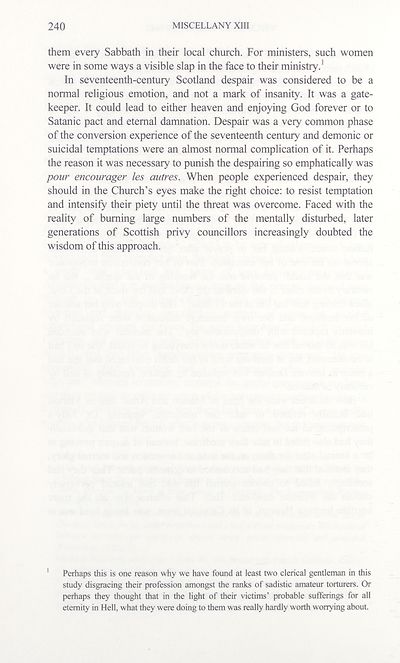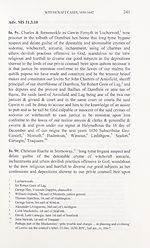Series 5 > Miscellany [of the Scottish History Society] XIII
(255) Page 240
Download files
Complete book:
Individual page:
Thumbnail gallery: Grid view | List view

240
MISCELLANY XIII
them every Sabbath in their local church. For ministers, such women
were in some ways a visible slap in the face to their ministry.'
In seventeenth-century Scotland despair was considered to be a
normal religious emotion, and not a mark of insanity. It was a gate¬
keeper. It could lead to either heaven and enjoying God forever or to
Satanic pact and eternal damnation. Despair was a very common phase
of the conversion experience of the seventeenth century and demonic or
suicidal temptations were an almost normal complication of it. Perhaps
the reason it was necessary to punish the despairing so emphatically was
pour encourager les autres. When people experienced despair, they
should in the Church’s eyes make the right choice: to resist temptation
and intensify their piety until the threat was overcome. Faced with the
reality of burning large numbers of the mentally disturbed, later
generations of Scottish privy councillors increasingly doubted the
wisdom of this approach.
Perhaps this is one reason why we have found at least two clerical gentleman in this
study disgracing their profession amongst the ranks of sadistic amateur torturers. Or
perhaps they thought that in the light of their victims’ probable sufferings for all
eternity in Hell, what they were doing to them was really hardly worth worrying about.
MISCELLANY XIII
them every Sabbath in their local church. For ministers, such women
were in some ways a visible slap in the face to their ministry.'
In seventeenth-century Scotland despair was considered to be a
normal religious emotion, and not a mark of insanity. It was a gate¬
keeper. It could lead to either heaven and enjoying God forever or to
Satanic pact and eternal damnation. Despair was a very common phase
of the conversion experience of the seventeenth century and demonic or
suicidal temptations were an almost normal complication of it. Perhaps
the reason it was necessary to punish the despairing so emphatically was
pour encourager les autres. When people experienced despair, they
should in the Church’s eyes make the right choice: to resist temptation
and intensify their piety until the threat was overcome. Faced with the
reality of burning large numbers of the mentally disturbed, later
generations of Scottish privy councillors increasingly doubted the
wisdom of this approach.
Perhaps this is one reason why we have found at least two clerical gentleman in this
study disgracing their profession amongst the ranks of sadistic amateur torturers. Or
perhaps they thought that in the light of their victims’ probable sufferings for all
eternity in Hell, what they were doing to them was really hardly worth worrying about.
Set display mode to:
![]() Universal Viewer |
Universal Viewer | ![]() Mirador |
Large image | Transcription
Mirador |
Large image | Transcription
Images and transcriptions on this page, including medium image downloads, may be used under the Creative Commons Attribution 4.0 International Licence unless otherwise stated. ![]()
| Scottish History Society volumes > Series 5 > Miscellany [of the Scottish History Society] XIII > (255) Page 240 |
|---|
| Permanent URL | https://digital.nls.uk/127316589 |
|---|
| Description | Over 180 volumes, published by the Scottish History Society, containing original sources on Scotland's history and people. With a wide range of subjects, the books collectively cover all periods from the 12th to 20th centuries, and reflect changing trends in Scottish history. Sources are accompanied by scholarly interpretation, references and bibliographies. Volumes are usually published annually, and more digitised volumes will be added as they become available. |
|---|


